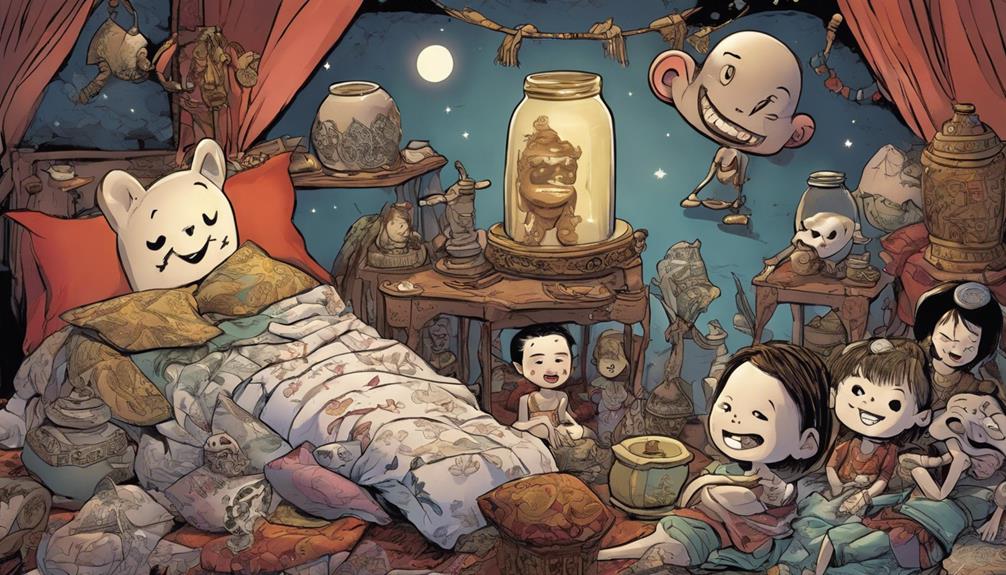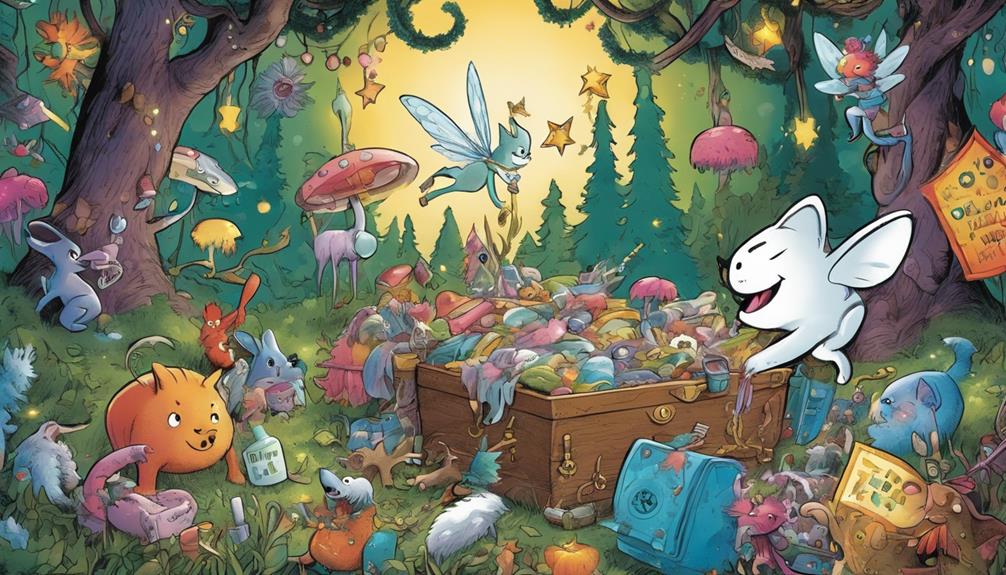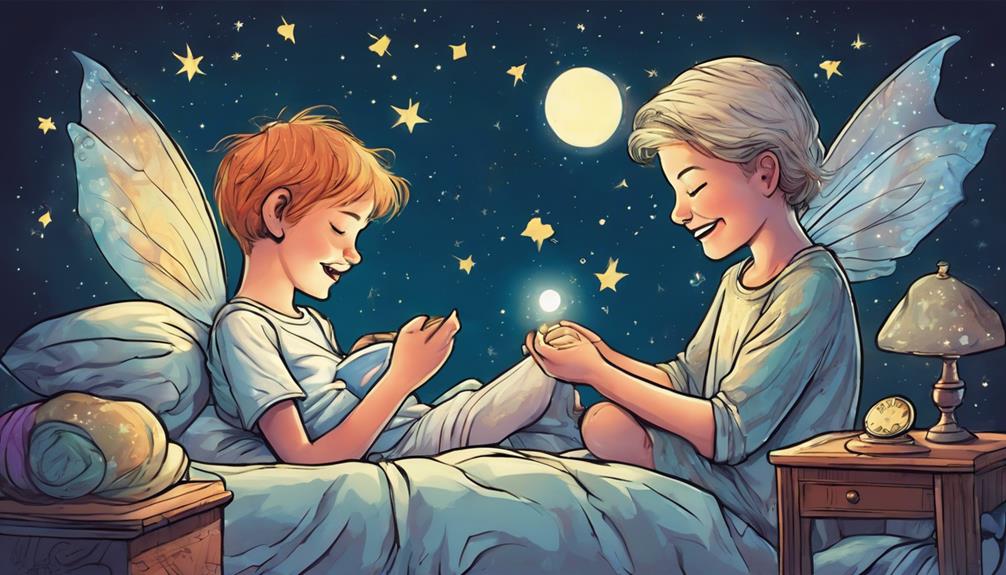The Tooth Fairy's amazing discoveries reveal the magic behind losing teeth and how it connects generations. You'll find that she transforms fear into joy, with parents spending around $4.13 per tooth to create cherished memories. The Tooth Fairy also shows how cultures worldwide celebrate this rite of passage. Fun traditions, like exchanging teeth for coins or gifts, turn tooth loss into a delightful experience. Plus, she encourages good oral hygiene habits while establishing a sense of responsibility in children. Discover more about her enchanting journey and the unique customs she's uncovered along the way.
Key Takeaways
- The Tooth Fairy discovered diverse cultural tooth traditions, revealing how children worldwide celebrate tooth loss uniquely through various customs.
- She found that children's emotional experiences during tooth loss create lasting memories, fostering joy and positive associations with oral health.
- The Tooth Fairy observed the economic impact of her tradition, with parents spending around $300 million annually on tooth-related gifts for children.
- She learned that personalized keepsake boxes and jewelry can preserve children's lost teeth, transforming them into cherished heirlooms and educational tools.
Origins of the Tooth Fairy

The Tooth Fairy's origins trace back to 17th-century European customs where parents would bury their children's lost teeth to encourage the growth of adult ones. This Tooth Fairy tradition highlights how cultures sought to make the change to adulthood a more magical experience. Instead of simply discarding lost teeth, families turned rituals into a comforting practice, promoting positive associations with growing up.
In the early 20th century, the Tooth Fairy made her American debut, with the first known reference appearing in the Chicago Daily Tribune on September 27, 1908. Over time, the concept evolved, and in 1927, Esther Watkins Arnold's short play solidified the Tooth Fairy's presence in children's folklore. This creative portrayal helped to shape the beloved figure we recognize today.
The idea of exchanging lost teeth for coins or gifts became a cherished practice in many households. The Tooth Fairy tradition not only eased the anxiety of losing a tooth but also transformed it into a whimsical event. As you share this magical moment with your own children, remember that this tradition has deep roots, connecting generations through the joy of childhood milestones.
Tooth Traditions Around the World

Across the globe, various cultures celebrate the loss of teeth with unique traditions that add a touch of magic to this childhood milestone.
In France, kids look forward to La Petite Souris, a charming mouse who swaps lost teeth for coins. This delightful custom traces back to 17th-century fairy tales. Meanwhile, in Spanish-speaking countries, El Ratoncito Pérez gathers lost teeth and rewards children with gifts. In Argentina, for instance, children often place their teeth in water for a special surprise.
In China, children make wishes on their lost teeth, with a clever twist: if they hide the tooth and find it after a year, it's believed they get another wish!
Nigeria's tooth disposal rituals vary by gender; boys toss eight stones while girls toss six, symbolizing the hope for strong, healthy teeth.
In Indonesia, kids throw their lost teeth in specific directions. A straight throw symbolizes the desire for straight teeth, while a crooked throw predicts the possibility of crooked teeth growth.
These diverse tooth traditions remind us that the Tooth Fairy story isn't just one tale; it's a world of enchanting customs that celebrate this important rite of passage.
The Magic of Losing Teeth

Losing teeth opens up a world of magic and excitement, turning a natural process into a memorable celebration for both kids and parents. The Tooth Fairy tradition helps ease the anxiety of losing baby teeth, transforming it into a rewarding experience. As your child loses teeth, it marks a significant milestone, signaling their growth and development.
Here's a glimpse of what happens during this magical time:
| Event | Details |
|---|---|
| Tooth Loss | Shift from baby teeth to adult teeth |
| Tooth Fairy Visit | Leaves gifts, averaging $4.13 per tooth |
| Emotional Impact | Creates lasting memories and joy |
| Oral Health Message | Encourages good hygiene practices |
Though children typically learn the Tooth Fairy isn't real between ages 5-7, around 75% continue to cherish the tradition. This playful myth reinforces positive associations with oral health, encouraging kids to maintain good hygiene habits. As you navigate this journey, embrace the magic of losing teeth—it's a wonderful time to create cherished memories that last a lifetime.
Creative Ways to Preserve Teeth

How can you creatively preserve your child's lost teeth to cherish those special moments? One of the best ways is by using a personalized keepsake box. You can store each tooth in this special container, creating a beautiful heirloom that holds memories of childhood milestones for future generations.
Another great option is jewelry creation. You can transform your child's lost teeth into unique pendants or charms, allowing you to wear these memories as meaningful accessories. This way, you keep a piece of their childhood close to your heart.
Additionally, consider using preserved baby teeth as educational tools. They can serve as excellent resources for teaching your child about the importance of oral hygiene and health. By discussing the properties of teeth, you can promote hands-on learning experiences, making dental care more engaging.
You might even explore the fascinating world of stem cell research, as baby teeth contain valuable stem cells. Preserving them could lead to potential medical advancements for your child's future health.
Promoting Children's Oral Health

Creating strong oral hygiene habits early sets the foundation for your child's lifelong dental health. As a parent, you can make this journey enjoyable by incorporating fun elements like the Tooth Fairy into daily routines.
Here are four effective ways to promote your child's oral hygiene:
- Make Brushing Fun: Use songs or stories about the Tooth Fairy to create excitement around brushing and flossing.
- Positive Reinforcement: Celebrate milestones like losing a tooth with small rewards, connecting them with the Tooth Fairy tradition.
- Regular Dental Visits: Schedule checkups and frame them as special appointments with the Tooth Fairy's helpers, emphasizing their importance in maintaining children's dental health.
- Educational Tools: Teach your child about the significance of their lost teeth and proper mouth care. Use visuals or books that feature the Tooth Fairy to reinforce these lessons.
Economic Impact of the Tooth Fairy

While promoting oral health can be a fun journey for kids, the economic impact of the Tooth Fairy reveals fascinating insights into childhood traditions and financial lessons. The Tooth Fairy serves an essential economic function, teaching children around the importance of money and transactions through the simple act of exchanging lost teeth for cash.
Here's a quick breakdown of the historical payments kids have received:
| Year | Average Payment |
|---|---|
| 1900 | $0.12 |
| 1975 | $0.85 |
| 1990 | $1.00 – $2.00 |
| 2000 | $2.00 – $3.00 |
| 2023 | $4.13 |
As you can see, the average payment has risen dramatically, reflecting inflation and changing cultural perceptions. This tradition not only provides kids with a small financial reward but also helps them understand economic transactions and responsibility. The Tooth Fairy has truly become a significant part of childhood experiences, shaping their views on money and its value as they grow.
The Tooth Fairy in American Culture

The Tooth Fairy has transformed greatly over the years, shaping the way you and your family celebrate lost teeth.
This whimsical tradition not only adds a touch of magic to childhood but also impacts your family's finances, as the average payout continues to rise.
Understanding this cultural evolution helps you appreciate the Tooth Fairy's lasting place in American life.
Cultural Evolution Over Time
As children in America enthusiastically await the arrival of the Tooth Fairy, the tradition reflects a cultural evolution that blends comfort, reward, and a sense of magic surrounding the loss of baby teeth. This enchanting figure has become an integral part of childhood, transforming from European customs into a uniquely American celebration.
Here are some key points about this cultural evolution:
- The Tooth Fairy first appeared in the early 20th century, with the Chicago Daily Tribune mentioning her in 1908.
- Esther Watkins Arnold's 1927 play, 'The Tooth Fairy,' popularized the myth, solidifying her role in American culture.
- The tradition shifted focus from European practices to an American narrative emphasizing reward and comfort for children losing baby teeth.
- As of 2023, the average gift from the Tooth Fairy has risen to $4.13 per tooth, showcasing a growing investment in this childhood rite.
Ultimately, the Tooth Fairy symbolizes childhood magic and innocence, helping children navigate the anxiety of losing baby teeth while promoting positive dental experiences. This ongoing cultural evolution continues to shape how families celebrate this milestone.
Economic Impact on Families
Celebrating the Tooth Fairy not only adds magic to childhood but also has a tangible economic impact on families, with parents collectively spending around $300 million each year on this beloved tradition.
The average monetary gift from the Tooth Fairy in the U.S. is now about $4.13 per lost tooth, a significant increase from just 12 cents in 1900. This rise reflects inflation and changing parental attitudes toward the value of lost teeth.
For many families, participating in this tradition teaches kids essential concepts about value and currency, effectively introducing them to basic economic principles. As children enthusiastically await the Tooth Fairy's visit, parents engage in a practice that mirrors other gift-giving traditions, like Santa Claus, reinforcing family bonds and childhood development.
The economic impact of the Tooth Fairy extends beyond individual households. With families spending an estimated $300 million annually, this phenomenon highlights how cultural rituals can shape economic behavior.
In the end, every lost tooth not only marks a milestone in childhood but also contributes to a broader economic narrative in American culture.
Fun Facts About the Tooth Fairy

National Tooth Fairy Day, celebrated on February 28 and August 22, highlights the enchanting tradition of exchanging lost teeth for surprises. If you're curious about the Tooth Fairy, here are some fun facts that make this magical figure even more special:
- Age of Discovery: Research shows that children usually realize the Tooth Fairy isn't real between ages 5 and 7, but 75% still cherish the tradition.
- Monetary Gifts: According to a survey by Delta Dental, the average monetary gift for a lost baby tooth in the U.S. is about $4.13.
- Positive Reinforcement: The Tooth Fairy helps alleviate fears children may have about losing teeth, transforming a potentially scary experience into a delightful one.
- Symbol of Growth: The tradition represents childhood magic while marking a significant change in maturity as children receive rewards for their lost teeth.
Next time your child loses a baby tooth, remember the joy of the Tooth Fairy and how she turns a simple moment into a cherished memory!
Engaging Kids With Dental Care

The Tooth Fairy's magical allure can turn dental care into an exciting adventure for kids, making it easier to instill good oral hygiene habits. When your child loses a tooth, it's not just about the Tooth Fairy's visit; it's a perfect opportunity to talk about the importance of dental care.
Share stories about the Tooth Fairy collecting lost teeth and leaving behind a special treat, creating a positive association with oral health.
Utilizing fun songs and engaging activities can further enhance your child's understanding of dental hygiene. Make brushing and flossing a playful routine, transforming mundane tasks into enjoyable experiences.
You might even create a Tooth Fairy chart to track your child's dental visits and progress.
Additionally, with the average Tooth Fairy gift rising to $4.13, you can teach your child about responsibility and financial literacy while celebrating their dental milestones.
By integrating the Tooth Fairy tradition into your child's life, you not only alleviate their fears about losing teeth but also reinforce the importance of maintaining healthy dental habits from an early age.
Embrace the magic, and watch your child thrive in their dental journey!
Frequently Asked Questions
What Is the Tooth Fairy Known For?
The Tooth Fairy's known for exchanging lost baby teeth under pillows for money, creating a magical experience for children. This tradition marks a rite of passage, blending excitement with a sense of growing up.
What Does the Tooth Fairy Collect?
When dreams flutter like butterflies, you'll find the Tooth Fairy collecting lost baby teeth. Each one's a tiny treasure, symbolizing growth and change, transformed into magic moments that fill your nights with wonder and excitement.
Is There Any Evidence of the Tooth Fairy?
There isn't any scientific evidence proving the Tooth Fairy's existence. While cultural traditions persist, they're rooted in folklore rather than facts. Most kids learn the truth about her by ages 5 to 7, yet still enjoy the magic. As children grow older, they may even take part in the tradition by playing along with younger siblings or friends, perpetuating the myth for the next generation. However, some parents have been known to have shocking tooth fairy discoveries, such as forgetting to exchange the tooth for money or accidentally waking their child while attempting to perform the tooth fairy duties. Despite these slip-ups, the legend of the Tooth Fairy continues to bring joy and excitement to children around the world.
What Is the Real Story of the Tooth Fairy?
You might find it amusing that the Tooth Fairy's real story blends ancient customs and modern whimsy. She represents childhood magic, celebrating milestones while soothing fears about losing teeth, transforming an ordinary experience into something extraordinary.
Conclusion
So, next time you tuck a tooth under the pillow, remember it's not just a ritual; it's a bridge between childhood innocence and the journey to adulthood.
The Tooth Fairy symbolizes the magic of growth and change, reminding us that every lost tooth is a step towards a brighter smile and healthier habits.
Embrace the wonder, celebrate the milestones, and encourage your child's excitement about dental care.
After all, every little tooth tells a story worth cherishing!









